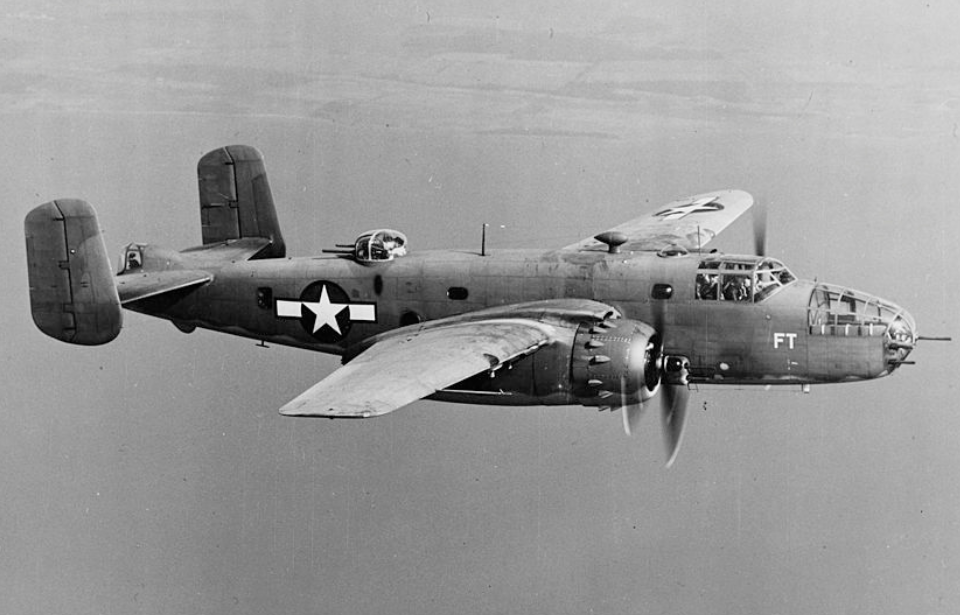The North American B-25 Mitchell was an American twin-engine medium bomber that saw service throughout the Second World War. Flying in all theaters of the conflict, it’s perhaps most famous for taking part in the Doolittle Raid on Japan in April 1942. By the end of the war, 9,816 had been built, seeing service across the US military and with multiple Allied air forces.
Development of the North American B-25 Mitchell
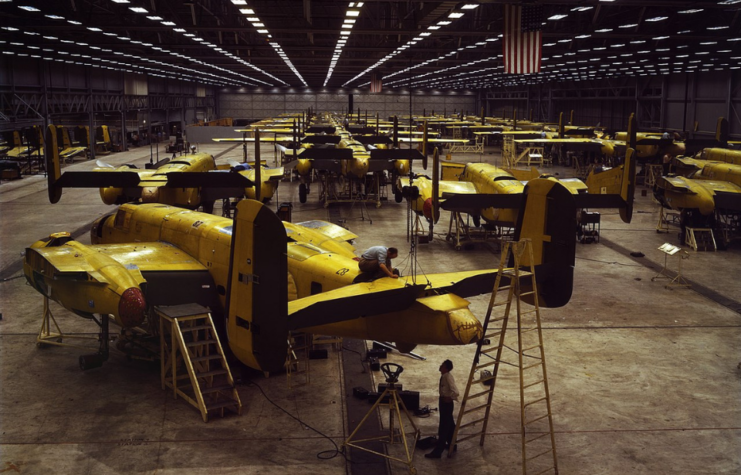
In March 1939, the United States Army Air Corps (USAAC) published requirements for a new twin-engine medium bomber that needed the ability to carry a 2,400-pound payload and travel up to 1,200 miles at 300 MPH. North American Aviation submitted the NA-62, a reworking of its NA-40B design. That September, the USAAC selected it, with the aircraft’s new designation being the B-25 Mitchell.
The B-25 flew for the first time on August 19, 1940. Early production models had issues with the wings, with the first nine having a wing dihedral – an upward-angled wing that made the bomber less stable. The problem was fixed by flattening the outer wing and keeping the angled one between the fuselage and the engines.
Other design changes, such as the enlarging of the bombers’ tail fins and changing their inward tilt, were made between 1940-41. The following year, the B-25B entered service with the US Army Air Forces (USAAF). After seeing combat, further modifications were made, allowing it to take on other roles, such as that of a gunship and strafer.
Durable and safe
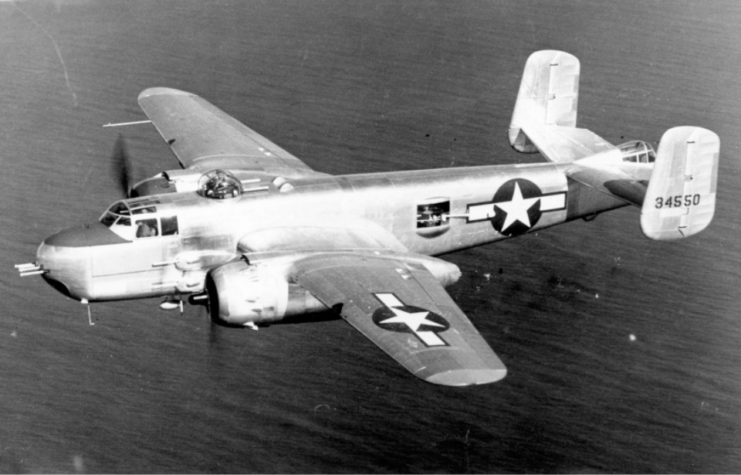
The B-25 Mitchell was a very safe and forgiving medium bomber. While in the air, if one engine was lost, it could still fly, making 60-degree banking turns at speeds as low as 145 MPH. The landing gear also provided the crew with visibility while taxiing.
The aircraft was known for its durability. For instance, one B-25C, nicknamed “Patches,” had each patch covering flak damage painted in yellow zinc chromate primer. It completed over 300 missions and six belly landings, and was pockmarked with over 400 holes from enemy fire.
The only complaint made by B-25 crews was the noise. The engine’s exhaust, due to restrictions in the design and space, pointed toward the crew compartments, which led to deafening flights.
North American B-25 Mitchell specs
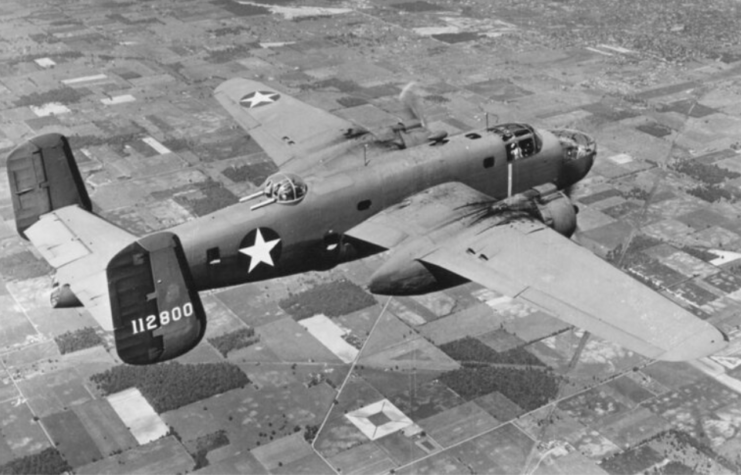
The B-25 Mitchell was nearly 53 feet long; had a wingspan of 67 feet, seven inches; and weighed 29,300 pounds. Depending on the variant, the bomber could be armed with up to 18 .50-cal. machine guns. It carried to 3,000 pounds of bombs, with later models given the ability to hold up to eight 5-inch high-velocity aircraft rockets (HVAR) or one Mark 13 torpedo. Some were even modified to carry a 75 mm cannon.
Two Wright R-2600-92 Twin Cyclone 14-cylinder two-row air-cooled radial piston engines, each producing 1,700 horsepower, powered the B-25. These allowed the bomber to maintain a cruising speed of 233 MPH and reach a maximum of 328 MPH. Its range topped out at around 2,500 miles with auxiliary fuel tanks, and it had a ceiling of 21,200 feet.
Doolittle Raid
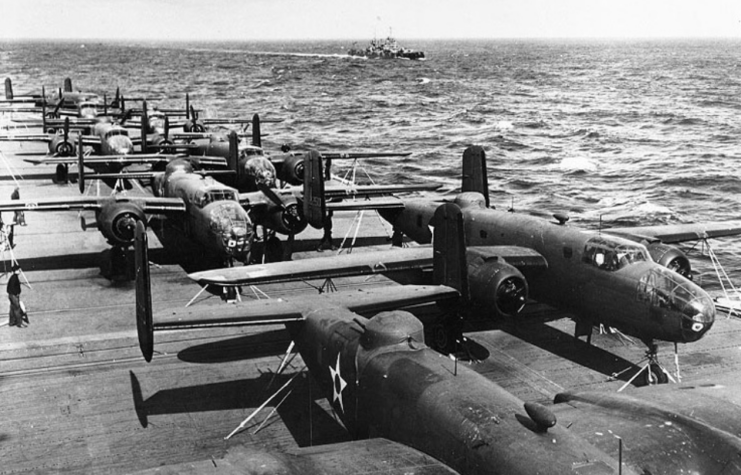
The B-25 Mitchell quickly shot to fame following its use during the Doolittle Raid. On April 18, 1942, 16 were launched from the USS Hornet (CV-8) to drop bombs on the Japanese cities of Tokyo, Yokohama, Yokosuka, Nagoya and Kōbe.
The bombers, along with their five-man crews and maintenance personnel, arrived aboard Hornet on April 1. Each would carry four 500-pound bombs, three high-explosive and one incendiary. To reduce the B-25s’ weight, their armament was reduced to two .50-caliber guns in the upper turret and a single .30-caliber gun in the nose.
On April 2, Hornet departed San Francisco Bay to join Task Force 16 (TF-16), made up of the aircraft carrier USS Enterprise (CV-6), along with three heavy cruisers, a light cruiser, eight destroyers and two fleet oilers. The vessels then sailed for Japan. On the 18th, TF-16 was roughly 750 miles from Japan. While they were 200 miles further away than planned, it was decided the attack would begin. Despite none of the B-25 pilots ever having taken off from a carrier, all 16 successfully launched from Hornet.
After flying for about six hours, the bombers reached Japan. During the attack, none of the B-25s were shot down, and only one received damage from anti-aircraft fire. Having dropped their bombs, 15 of the American aircraft turned to the southwest, toward eastern China. All 15 reached their destination, with their crews either crash-landing or bailing out. The last B-25, with extremely low fuel, flew to the Soviet Union, where the crew was detained and the bomber impounded.
While the Doolittle Raid caused relatively minor damage to Japan, it did show the Japanese that the Americans could attack the mainland. It also proved to be a great morale booster for the American public, showing that they were now in the fight after Pearl Harbor.
Extensive service throughout World War II
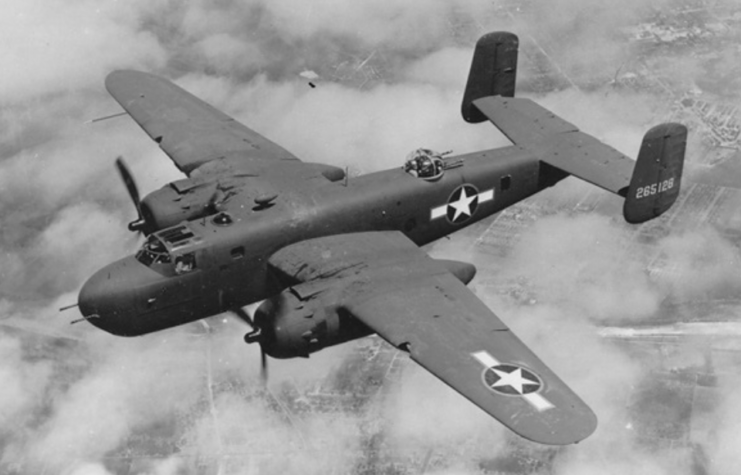
The B-25 Mitchell would go on to see service in all theaters of the Second World War. While the medium bomber’s primary operator was the United States, it served with numerous other air forces during the conflict. The Royal Air Force (RAF), for instance, received B-25s as part of the Lend-Lease Act and they were used for training in the Bahamas and as a bomber over Europe. The Royal Canadian Air Force also used the Mitchell for training purposes.
As well, the Royal Australian Air Force (RAAF) was equipped with the B-25, which it used as part of the No. 2 Squadron and the joint Australian-Dutch No. 18 (Netherlands East Indies) Squadron. While most air forces stopped using the aircraft after the war, the Indonesian Air Force continued to operate it until 1979, a testament to the aircraft’s abilities.
More from us: A B-52H Stratofortress Once Flew for Five Hours – Without a Tail!
Overall, the B-25 was the most-produced American medium bomber of the Second World War.
